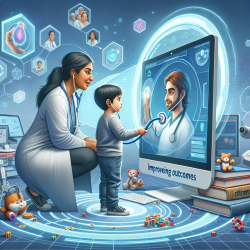Telemedicine has revolutionized healthcare delivery, particularly in pediatric care. The research article titled "Use of Telemedicine Healthcare Systems in Pediatric Assistance at Territorial Level: Consensus Document of the Italian Society of Telemedicine (SIT), of the Italian Society of Preventive and Social Pediatrics (SIPPS), of the Italian Society of Pediatric Primary Care (SICuPP), of the Italian Federation of Pediatric Doctors (FIMP) and of the Syndicate of Family Pediatrician Doctors (SIMPeF)" provides a comprehensive framework for implementing telemedicine effectively. This blog aims to help practitioners enhance their skills by implementing the research outcomes or encouraging further research.
Key Findings and Recommendations
The consensus document outlines several critical areas for telemedicine application in pediatric care:
- Home-Based Care: The patient's home can serve as the first place of prevention and care, particularly for chronic and disabling diseases. This model requires high-quality connectivity, shared criteria for home space analysis, and training pathways for healthcare personnel and families.
- Virtual Hospital: Leveraging information and communication technologies to create a multidisciplinary network for managing child health. This network can facilitate real-time information exchange and optimize health promotion, disease prevention, and chronic condition management.
- Teleconsultations and Telemonitoring: These tools can provide effective remote assessments and interventions, reducing the need for physical hospital visits. This is particularly useful in managing chronic conditions and providing psychological support.
Implementation Strategies
Practitioners can enhance their telemedicine skills by adopting the following strategies:
- Training and Education: Continuous education and training are crucial for healthcare professionals and families. Training should cover the use of telemedicine tools, data privacy, and cybersecurity.
- Standardization and Guidelines: Implement standardized clinical criteria and guidelines for telemedicine practices. This includes defining performance indicators and continuously auditing the processes.
- Technology Integration: Utilize reliable and accessible technology that is age-compatible and integrates seamlessly with traditional care services.
- Patient and Family Empowerment: Develop empowerment programs that include digital literacy and health management skills for patients and their families.
Encouraging Further Research
The consensus document highlights the need for ongoing research to optimize telemedicine practices. Practitioners are encouraged to participate in research studies, share their experiences, and contribute to developing new guidelines and best practices.
To read the original research paper, please follow this link: Use of Telemedicine Healthcare Systems in Pediatric Assistance at Territorial Level: Consensus Document of the Italian Society of Telemedicine (SIT), of the Italian Society of Preventive and Social Pediatrics (SIPPS), of the Italian Society of Pediatric Primary Care (SICuPP), of the Italian Federation of Pediatric Doctors (FIMP) and of the Syndicate of Family Pediatrician Doctors (SIMPeF).










